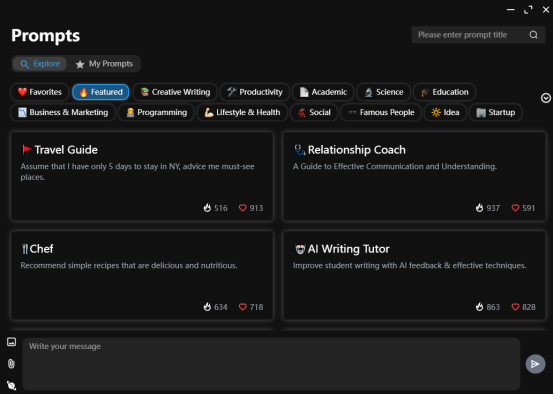DeepSeek R1 Prompt Application Encyclopedia: 17 Professional Templates to Double Your Work Efficiency

Why Does Your DeepSeek R1 Always Feel "Almost There"?
You open DeepSeek R1, input your question, wait for the answer… but the results always make you frown: "The response is quite long, but misses the key points." "The same question got a deep, thorough answer last time, but this time it's superficial."
This isn't just your frustration.
When DeepSeek R1 was released, its reasoning capabilities shocked the entire AI community—mathematical proofs, code debugging, logical deduction, complex problem decomposition… Its powerful chain of thought made professionals marvel, "This is true AI reasoning."
But after extensive use, I discovered an overlooked truth: DeepSeek R1's reasoning capabilities need to be "activated" by the right prompts.
It's like a precision scalpel—only when you master the correct usage can you unleash its true power.
- Vague prompts lead R1 into ineffective reasoning
- Confused instructions cause R1 to get lost in the chain of thought
- Lack of context makes R1 derive based on incorrect assumptions
At that moment, I understood:
To harness DeepSeek R1, you don't need more complex questions—you need more precise prompts.
What Makes DeepSeek R1 Special
Why Does R1 Require Different Prompting Strategies?
DeepSeek R1 has a key difference from ordinary AI models: it displays the complete thinking process. Like watching someone work through calculations on scratch paper, you can see every step of reasoning. This means:
- It will proactively discover and correct its own errors
- When encountering difficult problems, it will try multiple solutions
- It excels particularly at mathematics, programming, and logical analysis
But to truly unleash these capabilities, the key lies in how you ask questions. Good prompts are like giving R1 a clear map, letting it know which direction to think.
Five Key Principles for DeepSeek R1 Prompt Design

1. Explicitly Request Displayed Reasoning Process
Include in your prompt: "Please show complete reasoning steps," "analyze using chain-of-thought approach," "list the thinking process before giving conclusions."
For example:
When solving this problem, not only provide the answer, but also: first analyze key elements, list possible solution paths, choose the optimal path and explain why, derive step by step, and finally verify the answer's reasonability.
2. Use Structured Frameworks
R1 performs best when handling structured tasks. Adopt clear frameworks:
- Role Definition: Clarify R1's expert identity
- Objective Statement: Specify what task to complete
- Constraints: Format, length, requirement constraints
- Context Information: Necessary background
- Output Format: Expected presentation style
3. Provide Rich Context
Avoid making R1 make incorrect assumptions:
- Your knowledge level (beginner/professional)
- Use scenario (academic/business/personal)
- Special requirements (time constraints/compliance requirements)
4. Guide Thinking Step-by-Step
Break complex tasks into clear steps, using structures like "First… then… next… finally" to let R1 proceed methodically.
5. Clarify Output Standards
Tell R1 what kind of answer you expect: how long, what format, what elements to include, what content to avoid.
DeepSeek R1 Practical Prompt Library
I. Deep Reasoning and Analysis

1. Complex Problem Decomposition
Act as a systems analysis expert and break down complex problems into manageable sub-problems. For [specific problem], analyze as follows: First, restate the core problem in your own words, then list all key variables and known conditions, break the problem into 3-5 sub-problems and draw a dependency diagram, provide solution methods for each sub-problem, finally integrate into a complete solution and verify feasibility through counterexamples. Each reasoning step must be explicitly stated, pointing out information or assumptions that need supplementing. If there are multiple solutions, compare their pros and cons.
2. Causal Relationship Analysis
As a causal reasoning expert, analyze the causal relationship between [Phenomenon A] and [Phenomenon B]. Follow these steps: Test whether A and B have statistical correlation, verify whether A precedes B temporally, explain the specific mechanism by which A affects B, exclude possible confounding factors (are there third variables affecting both A and B), test for reverse causation, analyze whether changes in A's intensity lead to corresponding changes in B, finally propose experimental designs to verify the causal relationship. Please distinguish between "correlation" and "causation," label reasoning certainty levels, and list analysis limitations.
3. Logical Flaw Detection
As a critical thinking expert, examine the logical rigor of the following argument: [insert argument content]. First analyze the argument structure—what are the premises, what is the conclusion, are there leaps in reasoning. Then check item by item for logical fallacies: equivocation, circular reasoning, strawman fallacy, slippery slope fallacy, appeal to authority or emotion, false dilemma, reverse causation. Next, identify all implicit assumptions that the argument relies on but doesn't explicitly state, and evaluate their reasonability. Provide at least 2 counterexamples that could challenge this argument, and suggest how to modify it to make it more rigorous. Label the severity of each problem.
II. Programming and Technical Development

4. Algorithm Design and Optimization
As an algorithm expert, design an efficient algorithm for [problem description]. First, formalize input, output, and constraints in mathematical language, then provide the most intuitive brute force solution and analyze complexity. Next, explore optimization strategies: choose appropriate data structures (hash tables, heaps, trees, graphs) and algorithmic paradigms (greedy, dynamic programming, divide and conquer, backtracking), apply pruning and preprocessing techniques.
Provide [Python/Java/C++] implementation code with detailed comments. Rigorously derive time and space complexity, provide 3 sets of test data (regular, boundary, extreme cases), finally discuss time-space tradeoffs and practical application considerations.
5. Code Refactoring
As a code quality expert, refactor the following code: [paste code].
Optimize from five dimensions:
1) Readability—optimize naming following [naming conventions], break down complex logic, add comments 2) Structure—extract repeated code into functions, apply design patterns, modular reorganization 3) Performance—eliminate redundant calculations, optimize data structures, reduce I/O 4) Robustness—add exception handling, input validation, boundary checking 5) Testability—decouple dependencies
Output the complete refactored code, use tables to compare before and after differences, and note refactoring risks. Use [specified language], follow [code standards].
6. Technical Solution Selection
As a technical architect, choose a technical solution for [project description]. Requirements background includes: business scenario, performance requirements (QPS/latency/concurrency), team tech stack, budget constraints, launch timeline. Please list at least 3 alternative solutions (each with tech stack explanation), then score from 8 dimensions (1-10 points): performance, development efficiency, learning curve, community ecosystem, maintainability, cost, scalability, security. Assess each solution's technical maturity risk, team fit risk, vendor dependency risk. Create a weighted scoring table to give recommended solution, finally provide POC validation plan and phased migration strategy.
III. Data Analysis and Scientific Computing
7. Exploratory Data Analysis
As a data scientist, conduct comprehensive EDA on [dataset description]. First give data overview: dimensions, variable types, missing value statistics. Perform univariate analysis: descriptive statistics and distributions for numerical variables, frequency percentages for categorical variables, detect outliers using IQR or Z-score. Multivariate analysis includes: correlation matrix for numerical variables, cross-tabulation for categorical variables, relationship visualization. Assess data quality: consistency, duplicate records, type errors. Propose feature engineering suggestions: variables needing transformation, possible feature combinations, skewed distribution handling. Provide 3-5 key findings and future exploration directions. Provide [Python/R] implementation code and visualization suggestions.
8. A/B Test Analysis
As a statistical analysis expert, analyze A/B test results. Experiment information: control group A [sample size/metrics], experiment group B [sample size/metrics], test metrics, test duration. Please complete:
1) Clearly state H0 and H1, select test method (t-test/chi-square/Mann-Whitney U), calculate p-value and confidence interval 2) Assess effect size (Cohen's d/relative lift %) to judge business significance 3) Analyze statistical power—is sample size sufficient, if not significant, how many samples needed 4) Apply Bonferroni correction if multiple metrics 5) Segment by user group/device/region to identify heterogeneous effects 6) Provide statistical conclusions and business recommendations (full rollout/continue testing/abandon) and risk warnings 7) Develop follow-up action plan
Output complete report including statistical test details, visualization charts, and decision recommendations.
IV. Academic Research and Learning

9. Literature Review Generation
As an academic researcher, write a literature review on "[research topic]". Research scope: [discipline field], [time range], [literature types].
Structure includes:
1) Research background—problem importance and motivation 2) Theoretical framework—core concept definitions and mainstream schools 3) Methodological evolution—research method timeline, controversies and consensus 4) Key findings synthesis—organize by theme, identify consistent and contradictory conclusions 5) Research gaps and limitations—uncovered areas and methodological limitations 6) Future research directions—3-5 directions worth exploring and interdisciplinary opportunities
Use academic standard language, maintain objectivity and neutrality, conduct critical analysis rather than simple enumeration, cite using [author, year] format. Output 3000-5000 word review including research development diagram.
10. In-Depth Knowledge Explanation
As a teaching expert, provide in-depth explanation of [knowledge point]. Target learners: [learning background].
Develop following structure:
1) Introduce concept with everyday analogies, explain why learn this 2) Provide precise definition, break down key terms 3) Demonstrate application with 3 examples from simple to complex 4) Contrast easily confused concepts, list difference table 5) Design 3 practice problems (basic/advanced/challenge level) with detailed explanations 6) Summarize knowledge framework diagram, mark connections to other knowledge points 7) Recommend advanced learning resources
Explain in accessible language, avoid textbook copying, use expressions like "it's like…" "can be understood as…"
V. Business and Strategy
11. Business Model Canvas
As a business strategy consultant, construct a business model canvas for [company/product].
Analyze 9 modules:
1) Customer segments—identify 3-5 target groups, characteristic profiles, priorities 2) Value propositions—core value for each group, pain points solved, differentiation advantages 3) Channels—customer touchpoints, online-offline mix, efficiency assessment 4) Customer relationships—relationship types, lifecycle management, retention strategies 5) Revenue streams—revenue model, pricing strategy, forecast 6) Key resources—physical/intellectual/human/financial resources 7) Key activities—core activities, processes, quality control 8) Key partnerships—partners, suppliers, cooperation motivations 9) Cost structure—fixed/variable costs, economies of scale, optimization paths
Check consistency among 9 modules, identify contradictions, conduct SWOT analysis and competitive advantage assessment. Output visualized canvas and detailed explanation.
12. Competitive Analysis
As a market research analyst, comparatively analyze [our product] versus [Competitors A, B, C].
Compare from 8 dimensions:
1) Market positioning—target users, brand positioning, price positioning 2) Product feature matrix—list 20-30 core features, mark each company's support status and unique features 3) User experience—usability score, UI style, onboarding process 4) Technical architecture—tech stack, performance metrics, scalability 5) Business model—pricing strategy, payment path, profitability 6) Market performance—share, user scale, growth trends, financing 7) Marketing strategy—acquisition channels, content marketing, community operations 8) SWOT analysis—each competitor's strengths and weaknesses, our advantages and disadvantages
Rank competitors by threat level, provide differentiation strategies, feature priority recommendations, and market opportunities. Output comparison tables, radar charts, and strategic action lists.
VI. Creative Content and Marketing
13. Marketing Copywriting
As a senior copywriter, create marketing copy for [product/activity]. Product information: name, 3-5 selling points, target audience [age/occupation/pain points], usage scenarios, price positioning.
Tasks:
1) Create 5 headline versions—curiosity-driven, benefit-direct, fear appeal, social currency, data-shocking 2) Write body following AIDA model (attention-grabbing opening, pain point resonance, how product satisfies needs, clear CTA) 3) Integrate specific numbers, user testimonials and scenarios, scarcity, social proof, risk reversal elements 4) Language should have rhythm, concrete descriptions, conversational tone 5) Adapt for 4 scenarios—WeChat Moments version (within 100 words), Xiaohongshu version (image-text), e-commerce detail page version (long copy with paragraphs), short video script version (30-second voiceover) 6) Provide 2 significantly different A/B test versions
Label applicable channels and expected effects for each version.
14. Content Topic Planning
As a content planning expert, plan one month of content topics for [account/brand]. Account information: field, target audience, current follower count, content format (image-text/video/audio).
Output includes:
1) 4 content theme pillars (long-term directions) 2) Weekly topic calendar (20-30 topics total)
- Draft title
- Core highlights (3-5 points)
- Suitable content format
- Expected data targets
- Publishing time recommendation 3) Hot topic forecast and leverage plan (industry events, holiday nodes) 4) Viral topic characteristic analysis (why these topics might go viral) 5) User interaction design (polls, Q&A, submissions)
Topics should cover different types: practical tutorials, case breakdowns, opinion pieces, emotional resonance, industry insights.
VII. Personal Growth and Productivity
15. Personalized Learning Plan
As a learning science expert, develop a systematic plan for learning [subject/skill]. Learner information: current level, daily available time, specific goals, learning preferences, deadline.
Design includes:
1) Use OKR to break down goal into 3-5 quantifiable milestones 2) Build knowledge dependency tree marking prerequisite knowledge 3) Divide into 4 phases—foundation building (core concepts, learning resources, daily tasks, assessment criteria), practical application (project-based learning, deliberate practice, weekly output), deep integration (advanced topics, case analysis, peer learning), consolidation and refinement (Feynman technique, creative projects, system summary) 4) Provide learning method tools—spaced repetition Anki, active recall, multimodal learning, review schedule 5) Design weekly self-tests, monthly review checklist, plan adjustment triggers 6) Motivation maintenance—achievement celebration points, learning communities, bottleneck response 7) List must-read books Top 3, quality courses, practice platforms
Output Gantt chart, task checklist, and resource package.
16. Career Development Planning
As a career planner, plan 3-5 year path for [current position]. Background: years of work, core skills, career interests, bottlenecks, expected income, location preferences. First use SWOT and career anchor analysis for current situation (strengths, weaknesses, opportunities, threats, career anchor type).
Design 3 paths: A) Professional deepening path—target position, required capabilities, annual milestones, learning plan, salary expectations B) Management transition path—target position, leadership requirements, transition preparation, experience accumulation C) Cross-domain innovation path—target direction, skill transfer strategy, transition period planning
List capability enhancement plan by priority (hard skills + resources, soft skills + scenarios, industry knowledge + tracking methods). Suggest networking and personal branding strategies, quarterly OKR action plan.
17. Decision Analysis Framework
As a decision analysis expert, help me make a rational choice about [decision matter]. Background information: [current situation], [available options], [decision constraints].
Analyze following process:
1) Clarify decision objectives—short-term goals, long-term goals, potential conflicts 2) Identify all feasible options (at least 3), including the "no decision" option 3) List key decision factors (8-10), assign weights by importance 4) Assess each option:
- Pros and cons analysis
- Risk list and occurrence probability
- Required resources and costs
- Best/worst/most likely outcomes 5) Create decision matrix (options × factors scoring table) 6) Conduct sensitivity analysis—which assumption changes would affect conclusions 7) Provide recommended option with reasons 8) Design post-decision monitoring indicators and exit mechanism
Help me see blind spots, challenge my assumptions, provide different perspectives.
Efficiently Using DeepSeek R1 on the XXAI Platform
You've now mastered 17 carefully crafted prompt templates. But how to manage and use them more efficiently? Perhaps you can try using XXAI.

XXAI has 100+ built-in industry prompt templates Beyond this article's core templates, XXAI also pre-loads:
- Financial analysis (investment research/risk assessment)
- Legal advisor (contract review/legal opinions)
- Medical consultation (case analysis/literature search)
- Educational design (curriculum design/teaching plans)
- Architectural engineering (design proposals/project reviews)
- And continuously updating…
Get Started Now
Visit XXAI to register, immediately get 100 free credits, and import this article's prompt library with one click.
From "Using AI" to "Mastering AI"
DeepSeek R1 represents a new height in AI reasoning capabilities, but a tool's power depends on the user's skill.
This guide provides you with:
- 17 professional prompt templates for core scenarios
- 5 key principles for prompt design
- Chain-of-thought activation and structured instruction methods
True mastery comes from practice. My recommendations:
- Start with one scenario - Choose the most frequently used task, test with this article's templates
- Record and optimize - Save effective prompts, fine-tune based on results
- Build personal library - Construct proprietary assets on platforms like XXAI
- Continuous iteration - AI is evolving, prompts should evolve too
Remember: The best prompts aren't copied, they're refined through practice.
Now, open DeepSeek R1, choose a prompt, and start your first deep conversation. You'll discover that when AI truly understands your intent, it can do far more than you imagined.